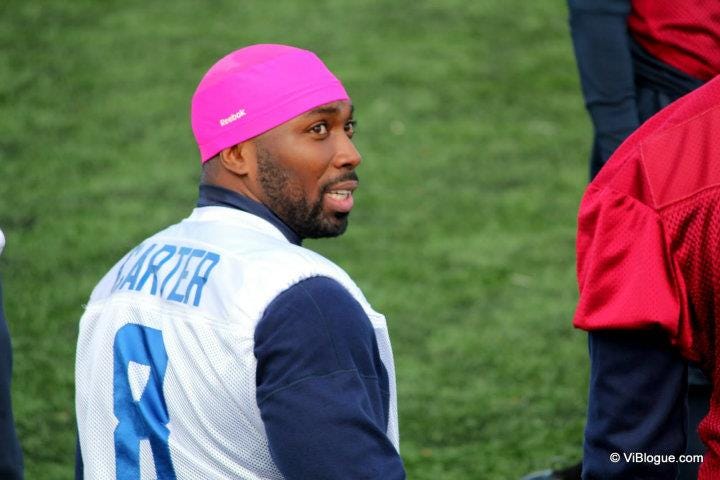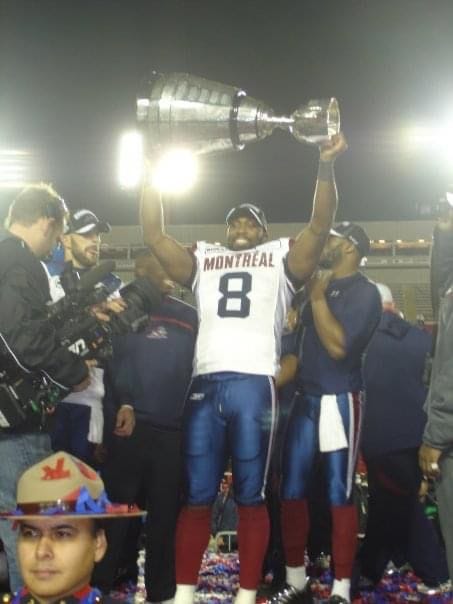Written by: Kerry Carter
"Do you even want to continue playing football?" Those words from our new head coach, Buddy Teevens, caught me off-guard as I sat in his office. Coming directly from the training facility, I listened to the voicemails and read the texts from my teammates and coaches that filled my inbox. Several members of our previous coaching staff reached out to check on me after learning the news. By now, everyone saw the headlines, and the word of Curtis' death was making its way around the entire team.
Do you even want to continue playing football?
Usually a question like that would be unthinkable, but it made sense coming from these new coaches. My shoulder surgery kept me out of our winter conditioning drills and spring practice, so the coaches didn't get to see me in any live-action. They had no gauge for my drive, resilience, or competitiveness. They didn't know me yet.
Still, part of me was insulted that he would even ask such a thing, even though part of me understood that it was an honest question. All I said in response was, "I love football, coach."
The truth was that I felt guilty after all that transpired. And that guilt lingered for far too long.
Before leaving his office that day, I asked to be updated on any funeral arrangements, as I wanted to pay my respects to Curtis. The coaching staff did not believe that it would be a good idea for me to attend, and once again, I reluctantly consented. Although I was constantly assured that there was no blame, they all thought it best to avoid taking any of the focus away from Curtis at the time of mourning for his loved ones.
My struggles continued throughout my final season in 2002, and so did the teams. We ended with a record of 2-9. It was a rather abrupt end to a roller-coaster four years on The Farm, our nickname for Stanford’s campus. Still, I had put together enough of a resume over my career to have a legitimate shot at making it to the NFL, and I set out on that journey.
This is when I really started feeling like myself again. I was on a mission to make it to the NFL and began my training regiment for the upcoming combine. All of my energy was focused on football, studying, and mental preparation. Nothing else existed.
In April of 2003, the Draft came and went without hearing my name called. If I wanted to continue my career, I would have to do it as a free agent and fight my way onto a team. My best opportunity was with none other than the Seattle Seahawks, which happens to be in the same state Curtis played his college football.
I considered it a blessing that I ended up in Seattle and wanted to use my platform to change the community positively. I jumped in headfirst and found ways to give back through my work with local schools, youth groups, and events around the city. I started a non-profit called the Think Big Foundation, which mirrored some of the structure of the Reikes Center facility back in Palo Alto.
For the next nine years, my career would play out across the NFL and CFL, starting with the Seattle Seahawks and the Washington Redskins. I spent two full seasons with the Seahawks and ended up signing with Washington after the 2005 season. In my first season with the Redskins I suffered a torn ACL that would cause me to miss the entire 2006 season. I didn't know it at the time, but that would be my last time playing on an NFL field. I was released the following spring and signed with the Montreal Alouettes in the Canadian Football League in the fall of 2007.
Initially, I planned on spending one year in the CFL to get some game film and help make my jump back to the NFL. I didn't want that dream to die just yet. However, once I immersed myself in the game and culture, I saw an opportunity to set myself up differently while still doing something I loved.
Unlike the NFL, an intense year-round commitment, the CFL at that time was essentially six months on and six months off. This scheduling allowed me to explore many opportunities outside the game during the off-season, and knowing that it could all end at any moment meant that I had a responsibility to set myself up for success after it was over.
The other main reason that I stayed in the CFL was that football was fun again. I was fortunate to be on a team with hard-working, focused leaders who loved the game and approached each day with the same passion I did. This passion showed up on the field as we were able to have tremendous success over this stretch going to three straight Grey Cup championships and winning two back to back in 2009 and 2010. The memories we made and the friendships forged over this run will stick with me forever.
I learned a lot about myself during the tough times. Recovering from injuries and losing seasons were struggles that caused me to doubt my abilities. Still, success taught me some valuable lessons as well. I got better at putting things aside as I walked through the door to the facility each day and not letting it affect my play. I also learned that I could pick them up when I left and address them directly without it weighing me down in other aspects of my life.
I learned about the power of daily motivation. Finding that anchor to focus my energy and manage how I reacted to situations gave me the calm confidence I was seeking. There is something about working together to achieve a collective goal that is bigger than yourself. It taught me how the need to rely on others was not a weakness but showed trust in those committed to the same outcome.
My experience in Montreal revitalized my career and my love for the game, but I knew that football would not last forever. As I neared the 9-year mark of my pro career, it was 2010; I was just 30 years old and wanted to find something that could be as all-encompassing as football had been for me since high school. I was aware of all the statistics surrounding retired players who went bankrupt within three years of not playing. I wanted to make sure that I didn't suffer the same loss of identity and struggle to reinvent myself in the business world.
I had built up all this equity around sports, and during the off-seasons, I spent time in Seattle learning about the technology space, mobile, and digital development. My final game for the Alouettes was in 2011, and although I had one year remaining on my contract, I felt that it was time for me to start the next chapter. I officially retired in June of 2012.
For the next five years, I took the entrepreneurial route.
I knew that I wanted to be at the intersection of sports and technology because I could add value to both sides of that equation. I wanted to leverage all I learned by playing the game and being in a leadership role on and off the field.
I started a marketing consulting company that worked with athletes. We did everything from building websites and social media campaigns to launching non-profits using large-scale events that engaged the local community.
There were significant successes and severe failures along the way, all great learning experiences that I attempted to build on. Not going the traditional route meant that I had the freedom to take risks but sometimes, admittedly, lacked the focus necessary to build a solid foundation for growth.
I moved back to Seattle after I retired. It may have been that environment, but occasionally, I found myself thinking about Curtis. I thought about the stories I had heard about him, his love for the game, and how I now had a unique opportunity to use my platform for something positive, more significant than myself.
I enjoyed the work I was doing on the events and marketing side of things, but I still felt I was missing something. It became challenging to muster the same amount of excitement for every project. I was beginning to get burned out by the pace, as I would be in the office all week and then at events almost every weekend. The passion I felt when I started was fading and I didn't have a clear roadmap to get to a destination I desired. There was a disconnect, and it all began to feel like work.
In the fall of 2015, I was back on the Stanford Campus to take in a game between Stanford and Washington. While visiting the football facility, I was requested to go into the office of coach Randy Hart. I didn't know him before this, but as we sat down, he told me that he was part of the staff at UW when the collision took place. He spoke to me about the tragedy of that day and the emotions that followed. Still, he expressed that no blame was placed on me by any of his teammates or coaches. Although it wasn't something I sought out, it was comforting to hear. It sparked something in me that would lead me to my current mission, the opportunity that I didn't even know I was preparing for.
I always held this tragedy in the back of my mind and used it as fuel to inspire and instill hope. Still, I didn't have the perfect outlet to directly affect what I believed to be somewhat of a calling. My ideal combination is an endeavor where my head and heart would be in complete alignment. I could do good while doing well for myself and my family.
A few months later, I found that in this Seattle start-up that was doing something interesting in the football space, specifically around tackling.






Loved this chapter. A lethal combo of facing failures and emerging out of them as a winner. For me everyone who has overcome something in life is a winner. I am looking forward to the next part. :)